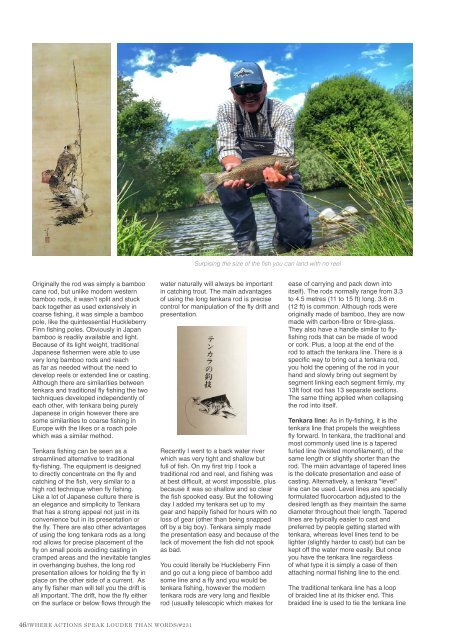You also want an ePaper? Increase the reach of your titles
YUMPU automatically turns print PDFs into web optimized ePapers that Google loves.
Surpising the size of the fish you can land with no reel<br />
Originally the rod was simply a bamboo<br />
cane rod, but unlike modern western<br />
bamboo rods, it wasn’t split and stuck<br />
back together as used extensively in<br />
coarse fishing, it was simple a bamboo<br />
pole, like the quintessential Huckleberry<br />
Finn fishing poles. Obviously in Japan<br />
bamboo is readily available and light.<br />
Because of its light weight, traditional<br />
Japanese fishermen were able to use<br />
very long bamboo rods and reach<br />
as far as needed without the need to<br />
develop reels or extended line or casting.<br />
Although there are similarities between<br />
tenkara and traditional fly fishing the two<br />
techniques developed independently of<br />
each other, with tenkara being purely<br />
Japanese in origin however there are<br />
some similarities to coarse fishing in<br />
Europe with the likes or a roach pole<br />
which was a similar method.<br />
Tenkara fishing can be seen as a<br />
streamlined alternative to traditional<br />
fly-fishing. The equipment is designed<br />
to directly concentrate on the fly and<br />
catching of the fish, very similar to a<br />
high rod technique when fly fishing.<br />
Like a lot of Japanese culture there is<br />
an elegance and simplicity to Tenkara<br />
that has a strong appeal not just in its<br />
convenience but in its presentation or<br />
the fly. There are also other advantages<br />
of using the long tenkara rods as a long<br />
rod allows for precise placement of the<br />
fly on small pools avoiding casting in<br />
cramped areas and the inevitable tangles<br />
in overhanging bushes, the long rod<br />
presentation allows for holding the fly in<br />
place on the other side of a current. As<br />
any fly fisher man will tell you the drift is<br />
all important. The drift, how the fly either<br />
on the surface or below flows through the<br />
water naturally will always be important<br />
in catching trout. The main advantages<br />
of using the long tenkara rod is precise<br />
control for manipulation of the fly drift and<br />
presentation.<br />
Recently I went to a back water river<br />
which was very tight and shallow but<br />
full of fish. On my first trip I took a<br />
traditional rod and reel, and fishing was<br />
at best difficult, at worst impossible, plus<br />
because it was so shallow and so clear<br />
the fish spooked easy. But the following<br />
day I added my tenkara set up to my<br />
gear and happily fished for hours with no<br />
loss of gear (other than being snapped<br />
off by a big boy). Tenkara simply made<br />
the presentation easy and because of the<br />
lack of movement the fish did not spook<br />
as bad.<br />
You could literally be Huckleberry Finn<br />
and go cut a long piece of bamboo add<br />
some line and a fly and you would be<br />
tenkara fishing, however the modern<br />
tenkara rods are very long and flexible<br />
rod (usually telescopic which makes for<br />
ease of carrying and pack down into<br />
itself). The rods normally range from 3.3<br />
to 4.5 metres (11 to 15 ft) long. 3.6 m<br />
(12 ft) is common. Although rods were<br />
originally made of bamboo, they are now<br />
made with carbon-fibre or fibre-glass.<br />
They also have a handle similar to flyfishing<br />
rods that can be made of wood<br />
or cork. Plus, a loop at the end of the<br />
rod to attach the tenkara line. There is a<br />
specific way to bring out a tenkara rod,<br />
you hold the opening of the rod in your<br />
hand and slowly bring out segment by<br />
segment linking each segment firmly, my<br />
13ft foot rod has 13 separate sections.<br />
The same thing applied when collapsing<br />
the rod into itself.<br />
Tenkara line: As in fly-fishing, it is the<br />
tenkara line that propels the weightless<br />
fly forward. In tenkara, the traditional and<br />
most commonly used line is a tapered<br />
furled line (twisted monofilament), of the<br />
same length or slightly shorter than the<br />
rod. The main advantage of tapered lines<br />
is the delicate presentation and ease of<br />
casting. Alternatively, a tenkara "level"<br />
line can be used. Level lines are specially<br />
formulated fluorocarbon adjusted to the<br />
desired length as they maintain the same<br />
diameter throughout their length. Tapered<br />
lines are typically easier to cast and<br />
preferred by people getting started with<br />
tenkara, whereas level lines tend to be<br />
lighter (slightly harder to cast) but can be<br />
kept off the water more easily. But once<br />
you have the tenkara line regardless<br />
of what type it is simply a case of then<br />
attaching normal fishing line to the end.<br />
The traditional tenkara line has a loop<br />
of braided line at its thicker end. This<br />
braided line is used to tie the tenkara line<br />
46//WHERE ACTIONS SPEAK LOUDER THAN WORDS/<strong>#231</strong>
















